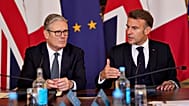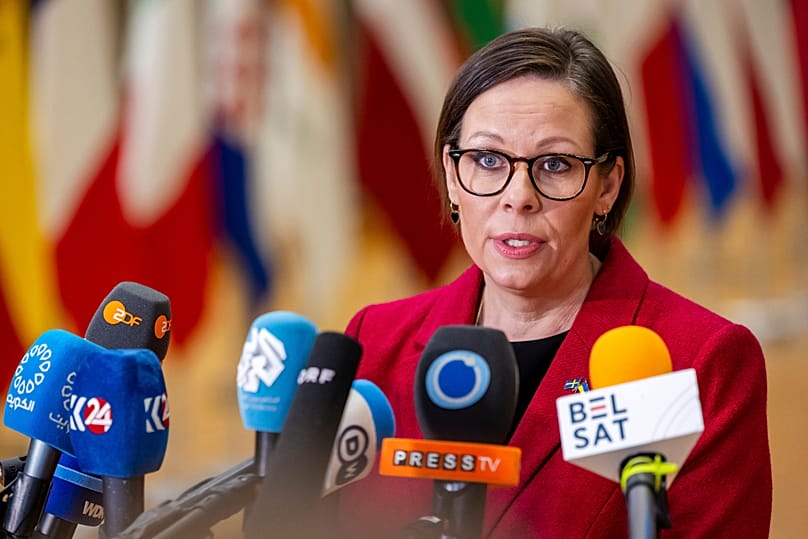Sweden's foreign minister claimed last week that Europe has imported more from Russia during the war than it has spent supporting Ukraine. A review of the numbers suggests she is right.
A post from Swedish Foreign Minister Maria Malmer Stenergard went viral online last Thursday, claiming that EU imports from Russia since the start of its full-scale invasion of Ukraine exceeded the amount of aid given to Kyiv by Europe.
According to Stenergard, "European countries and Europe" have supported Ukraine with €187 billion.
"During the same period, we have imported Russian oil and gas to an amount of €201 billion," Stenergard said. "And then, if you add the other imports, then the total is €311 billion."
She told reporters in Brussels that this represents "negative support to Ukraine of €124 billion".
But are Stenergard's figures correct? We examined her claims using publicly available data and found her calculations to be broadly accurate, depending on which data were used and how "aid" is defined.
How much does Europe import from Russia?
Since Moscow's full-scale invasion of Ukraine, the EU has slapped sanctions on Russian energy products in an effort to reduce Europe's heavy pre-war dependence on Russian oil and gas.
Europe's imports from Russia have plunged by around 89% since the start of the invasion, according to Eurostat, but remain substantial.
Research from the independent Centre for Research on Energy and Clean Air (CREA) indicates the EU's member states have purchased more than €216 billion in Russian fossil fuels — including oil, refined products, pipeline gas and liquefied natural gas (LNG) — since February 2022.
According to the CREA, in October 2025, Russia's monthly fossil fuel export revenues fell to their lowest since the start of the full-scale invasion.
The EU is, however, still the largest buyer of LNG. Its top five importers — Hungary, Slovakia, France, Belgium and Romania — paid a combined €938 million for Russian fossil fuels in the month of October 2025 alone, CREA reports.
In October, the European Council said that Russian gas still accounts for an estimated 13% of EU imports in 2025 — a drop from 18% the year prior — but still significant.
Natural gas remains unsanctioned, and the EU has set a deadline for 2027 for all 27 member states to phase out all remaining purchases. This timeline has been challenged, notably by Hungary, which has sought exemptions to the proposed arrangements.
Issac Levi, energy analysis team lead at CREA, told Euronews' fact-checking team, The Cube, that imports "that remain outside of the sanctions framework — LNG, TurkStream pipeline gas, and crude via the Druzhba pipeline to Hungary and Slovakia — have persisted or even increased, allowing significant Russian revenue streams to continue".
Including oil and gas along with other imports, Eurostat data analysed by Reuters in August shows that the EU imported €297 billion since February 2022 — including fertiliser, nickel and iron and steel.
How much has Europe given to Ukraine?
Stenergard's comparison broadly aligns when using European Commission headline figures and estimated total import data.
According to a headline tally released by the European Commission, the EU and its member states have provided Ukraine with more than €187 billion of support since February 2022, with highly concessional loans representing around 35% of that total.
The Cube reached out to the European Commission, which pointed us back to this figure.
Using this definition, Stenergard's numbers are roughly consistent in that Europe has indeed imported more from Russia — particularly Russian oil and gas — than it has spent on aid to Ukraine since the start of the war.
Research from the Kiel Institute, which tracks allocated support to Ukraine, indicates the number is initially lower under its definition of allocated aid.
Allocations show what governments have agreed to provide, not what has been fully paid out. Actual disbursements can be lower or take longer to materialise.
According to the Kiel Institute, EU institutions and member states have already allocated €150 billion to Ukraine since the start of the invasion.
Looking at geographic Europe as a whole, and including non-EU member states such as Norway, Switzerland, Iceland and the UK, the amount of total allocated aid is €177 billion.
These numbers include bilateral financial, military and humanitarian support compiled from government budget documents, official announcements and other publicly available sources, the institute said.
In addition to allocations, European governments have made further commitments but have not yet allocated pledges.
For the EU and its member states, total commitments amount to €214 billion. For the whole of geographic Europe total commitments reach €273 billion.
This narrows the gap between numbers for Russian imports and aid, but does not necessarily close it.
The Kiel Institute's numbers also do not include costs for hosting Ukrainian refugees fleeing the war that have been absorbed by European countries.
The Kiel Institute says that in a hypothetical upper-bound estimate, in which all Ukrainian refugees are understood to rely on public support, Europe would have spent €160 billion on hosting Ukrainian refugees since 2022. The actual number is likely lower.
These figures cover accommodation, education, healthcare and social support for Ukrainians who fled the war and are paid through European countries' domestic budgets.
Stenergard's comparison is therefore broadly accurate when using the European Commission's announcement of aid and comparing it to the EU's total imports from Russia.
However, if you include future commitments in Europe's overall financial response to the war, as reported by the Kiel Institute, as well as at least a certain amount of support Europe has paid for Ukrainian refugees, the gap highlighted by the minister narrows, but doesn't necessarily disappear.
Plugging future gaps
Despite humanitarian aid remaining relatively steady, the Kiel Institute's estimates show military aid for Kyiv has plummeted since the summer.
Military allocations to Ukraine from European countries fell by 57% compared to the first half of the year, when Europe stepped in and expanded its military support to plug a gap left by the US.
Last week, European Commission President Ursula von der Leyen implored European Union countries to reach an agreement by December to cover Ukraine's military and financial needs for the next two years.
That number is estimated at €135.7 billion, according to a letter sent on Monday and seen by Euronews, which presented three main options European member states could use to support Kyiv.


















